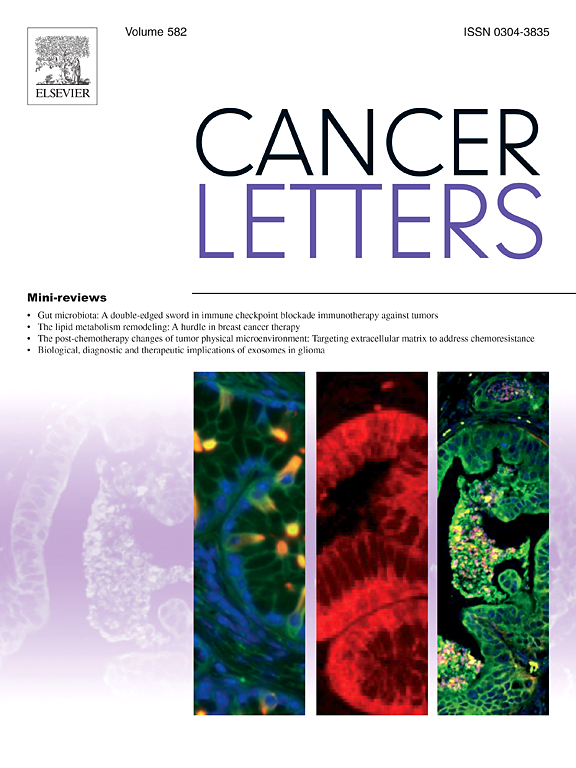泰拉格司他作为顺铂的放射增敏剂替代品,用于治疗头颈部鳞状细胞癌。
IF 9.1
1区 医学
Q1 ONCOLOGY
引用次数: 0
摘要
头颈部鳞状细胞癌(HNSCC)的放射治疗(RT)疗效受限于放射抗性和 FDA 批准的放射增敏剂的毒性。在我们之前的研究中,我们证明了替拉格那司他(CB839)在体外和体内 HNSCC 模型中提高了 RT 的疗效,在此,我们将替拉格那司他的放射增敏作用与顺铂的放射增敏作用进行了比较,因为顺铂是目前同时治疗的标准药物。在 HNSCC 患者异种移植小鼠模型中,替拉格纳司他与 RT 联合使用可减少肿瘤体积。在Cal27和HN5 HNSCC细胞中,替拉格纳司他与RT联用在降低细胞存活率和增加细胞凋亡方面的疗效与顺铂与RT联用相似,甚至更高。在 Cal27 和 HN5 细胞中,加入替拉格纳司他会增加活性氧并降低抗氧化剂谷胱甘肽。反相蛋白质阵列分析显示了细胞死亡和DNA损伤反应蛋白的变化。这项研究为将替拉格纳司他作为放射增敏剂用于治疗HNSCC提供了科学依据,它可以替代顺铂或用于不符合顺铂治疗条件的患者。本文章由计算机程序翻译,如有差异,请以英文原文为准。
Telaglenastat as an alternative to cisplatin as a radiosensitizer in the treatment of head and neck squamous cell carcinoma
The efficacy of radiation treatment (RT) of head and neck squamous cell carcinoma (HNSCC) is limited by radioresistance and the toxicity of FDA approved radiosensitizers. In extension to our previous research where we demonstrated that telaglenastat (CB839) increased efficacy of RT in in vitro and in vivo HNSCC models, here, we examine the radiosensitizing effects of telaglenastat in comparison to cisplatin's, as cisplatin is currently the standard of care for concurrent therapy. Combination of telaglenastat with RT reduced tumor volume in a HNSCC patient derived xenograft mouse model. The efficacy of telaglenastat with RT in reducing cell survival and increasing apoptosis was similar if not greater than that of cisplatin with RT in Cal27 and HN5 HNSCC cells. The addition of telaglenastat increased reactive oxygen species and reduced the antioxidant glutathione in both Cal27 and HN5 cells. Reverse Phase Protein Array analyses revealed alterations in cell death and DNA damage response proteins. This study provides the scientific underpinnings for the use of telaglenastat as a radiosensitizer in the treatment of HNSCC either as an alternative to cisplatin or in cisplatin-ineligible patients.
求助全文
通过发布文献求助,成功后即可免费获取论文全文。
去求助
来源期刊

Cancer letters
医学-肿瘤学
CiteScore
17.70
自引率
2.10%
发文量
427
审稿时长
15 days
期刊介绍:
Cancer Letters is a reputable international journal that serves as a platform for significant and original contributions in cancer research. The journal welcomes both full-length articles and Mini Reviews in the wide-ranging field of basic and translational oncology. Furthermore, it frequently presents Special Issues that shed light on current and topical areas in cancer research.
Cancer Letters is highly interested in various fundamental aspects that can cater to a diverse readership. These areas include the molecular genetics and cell biology of cancer, radiation biology, molecular pathology, hormones and cancer, viral oncology, metastasis, and chemoprevention. The journal actively focuses on experimental therapeutics, particularly the advancement of targeted therapies for personalized cancer medicine, such as metronomic chemotherapy.
By publishing groundbreaking research and promoting advancements in cancer treatments, Cancer Letters aims to actively contribute to the fight against cancer and the improvement of patient outcomes.
 求助内容:
求助内容: 应助结果提醒方式:
应助结果提醒方式:


